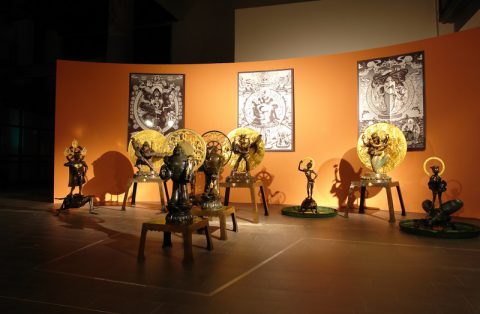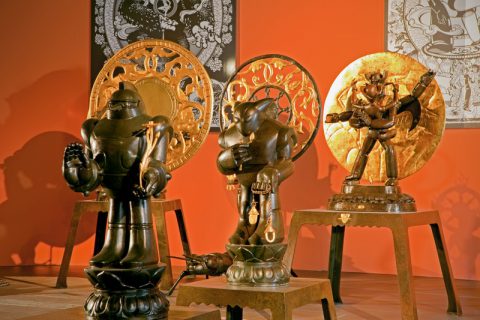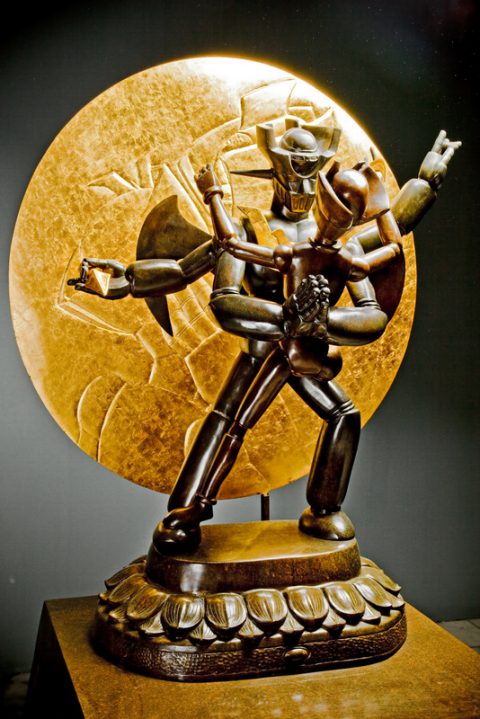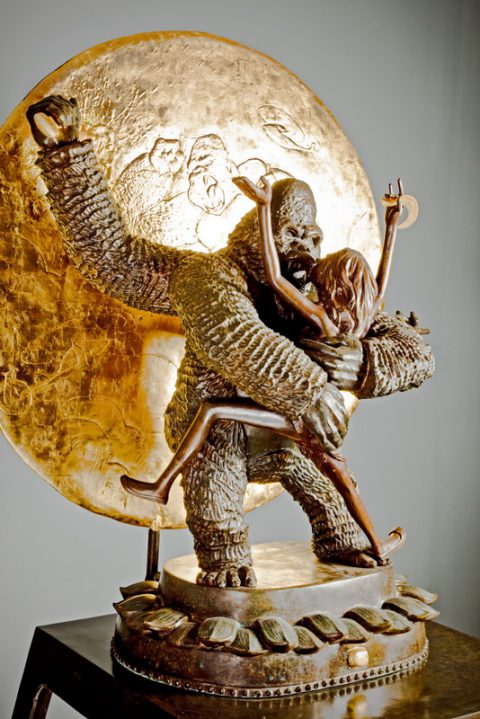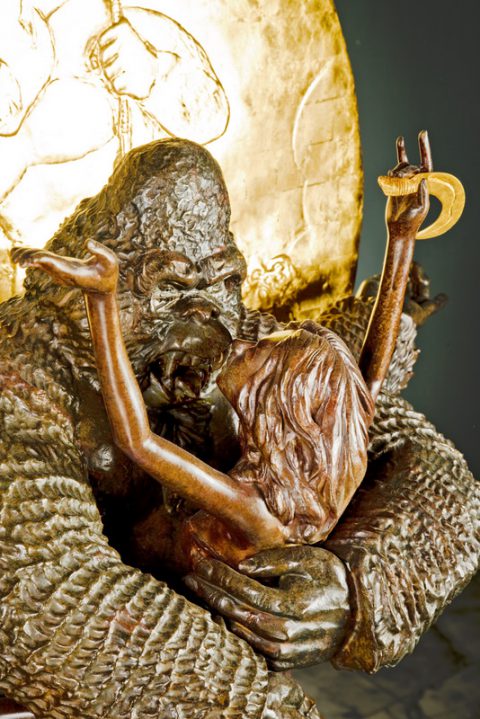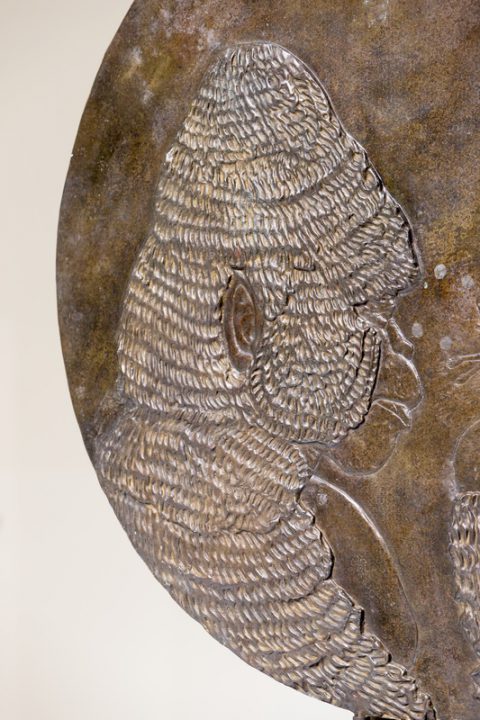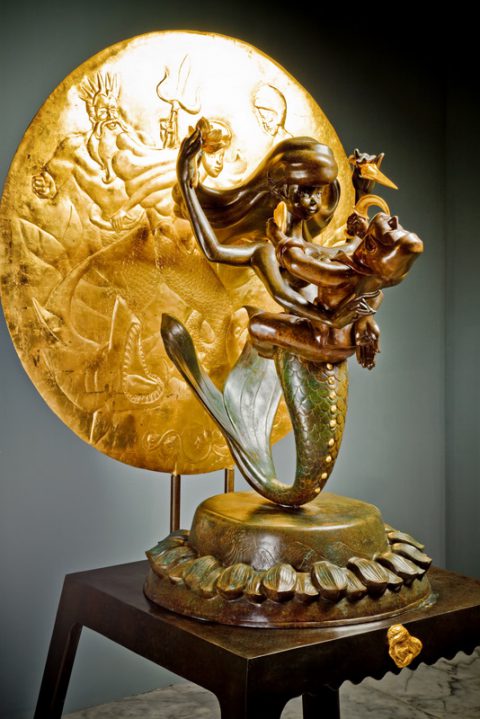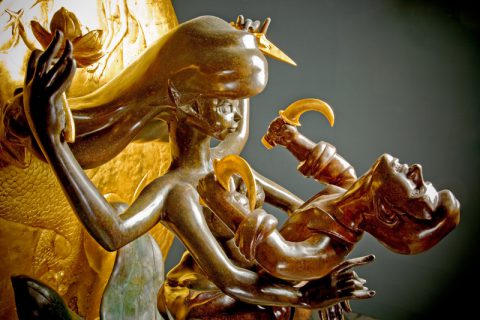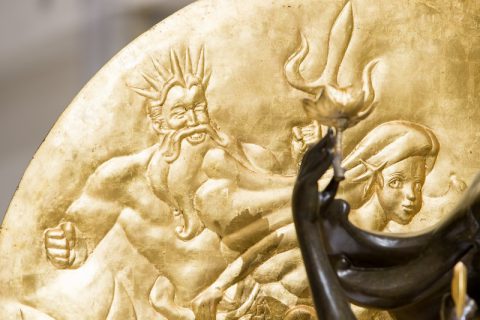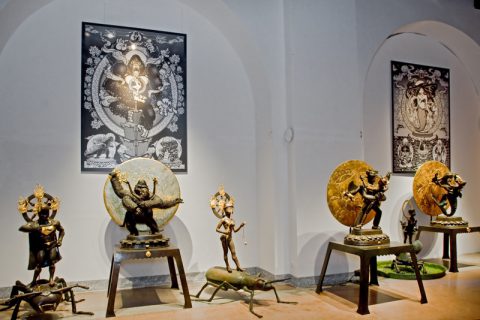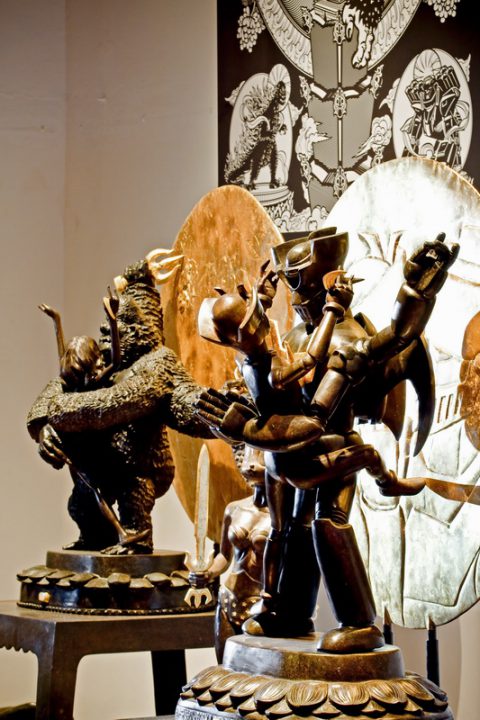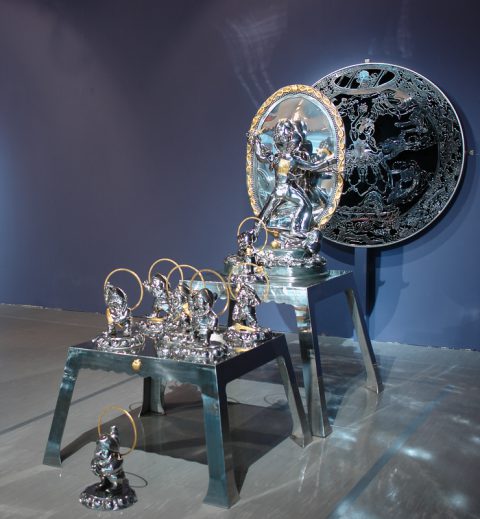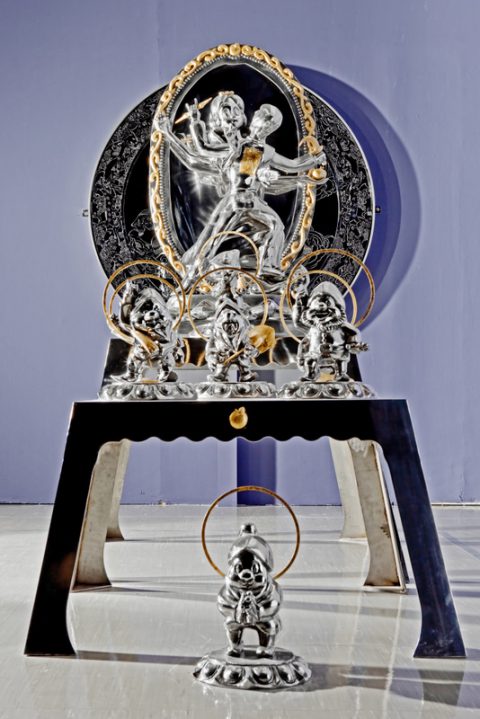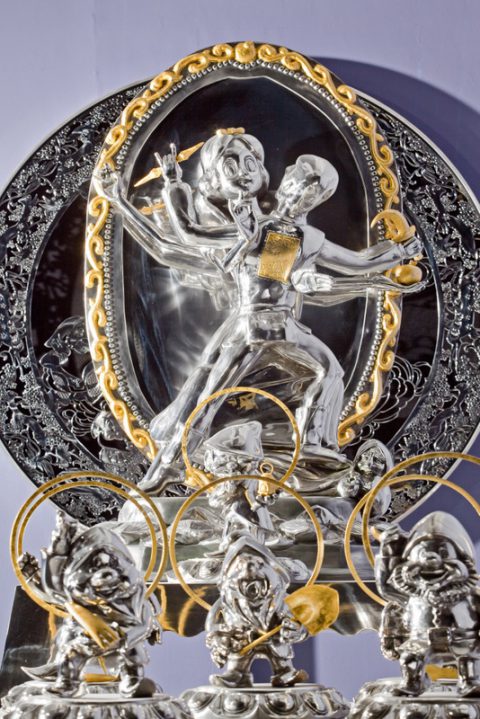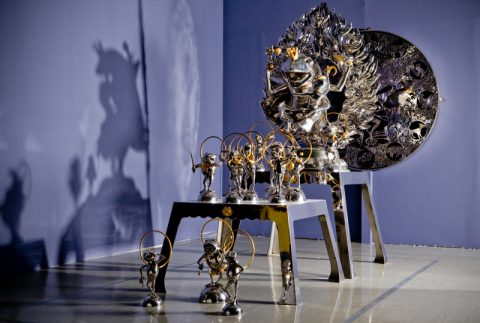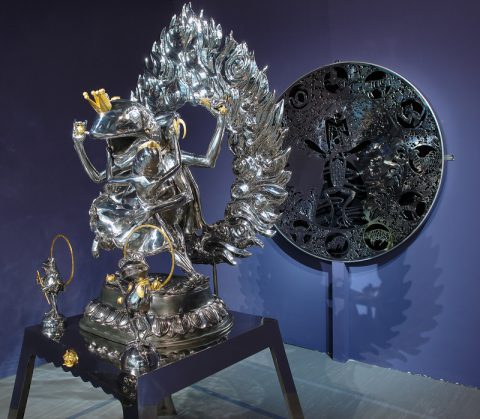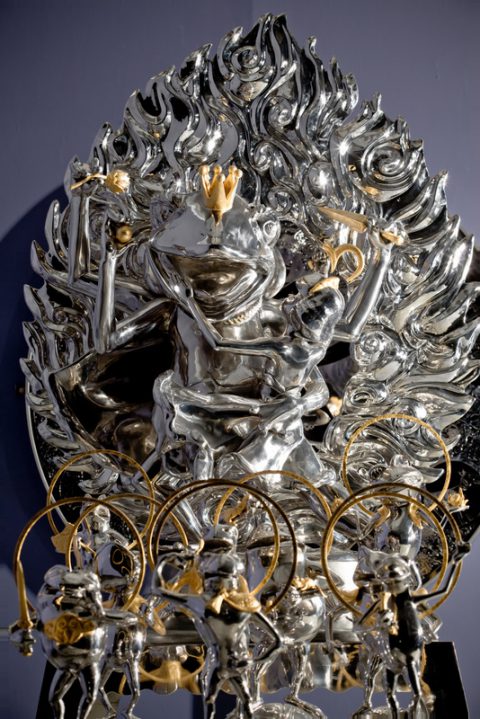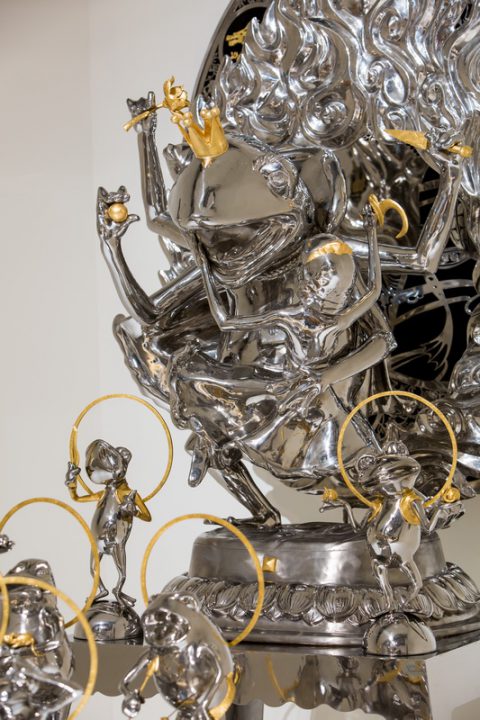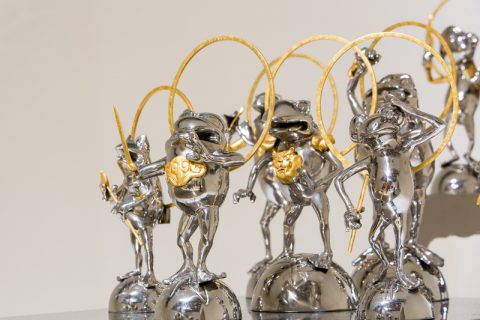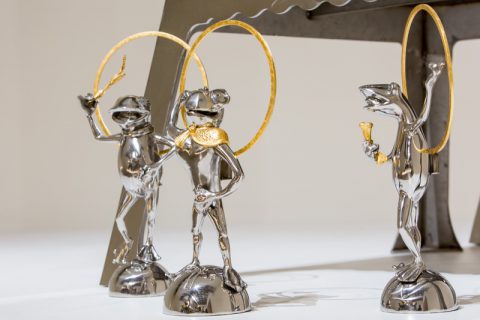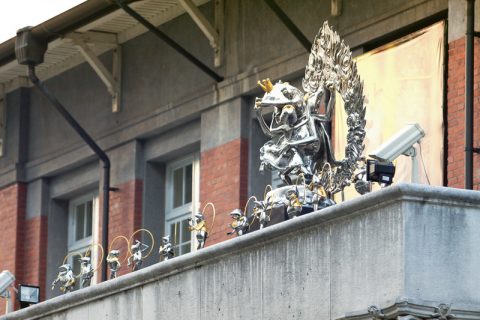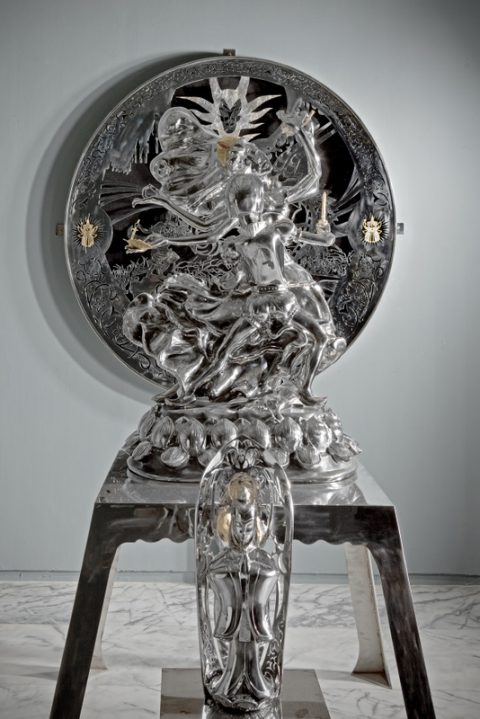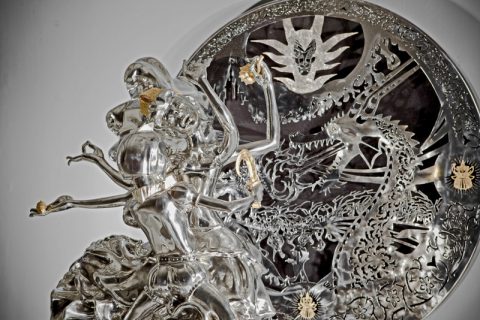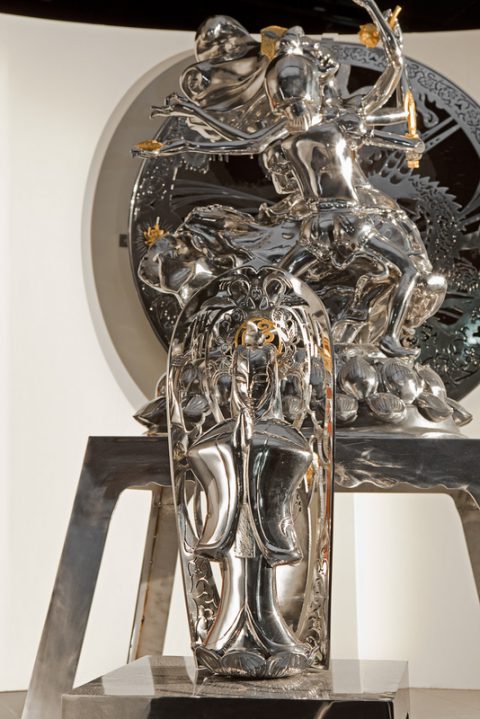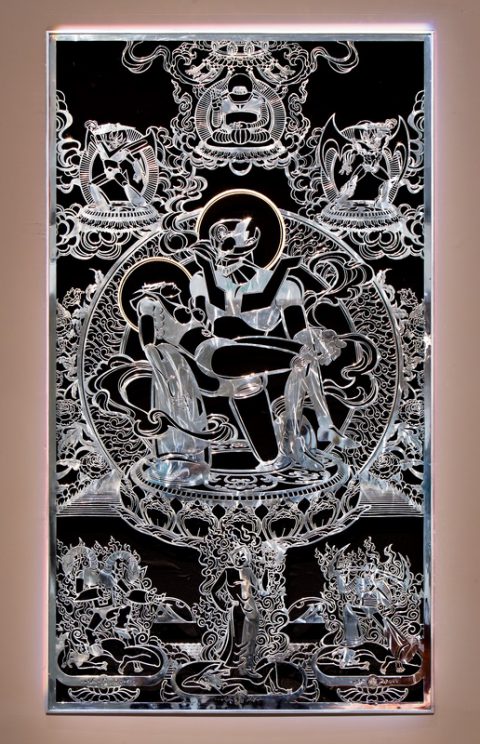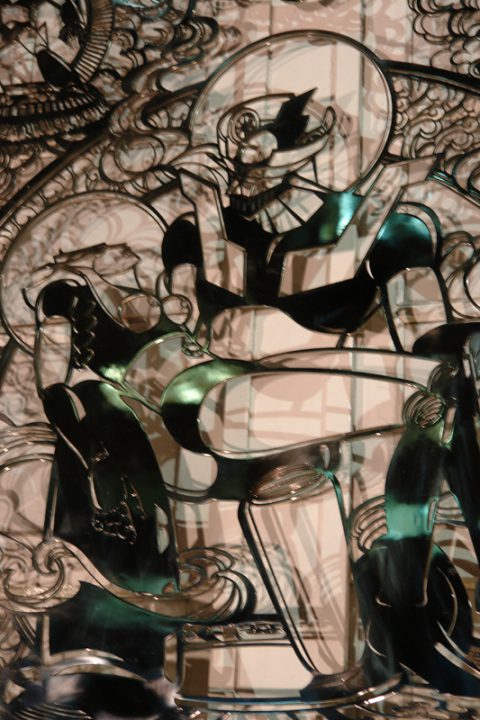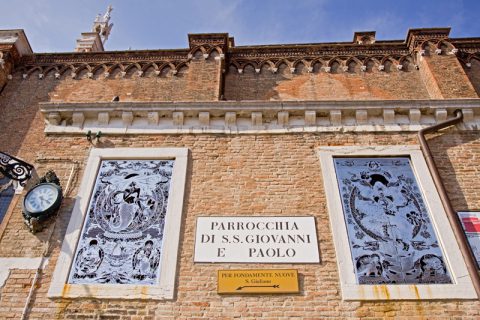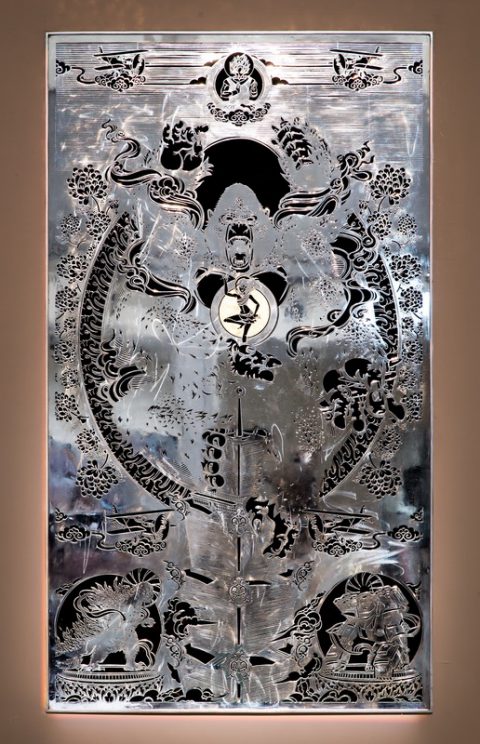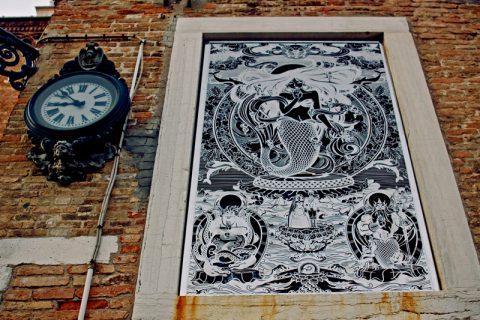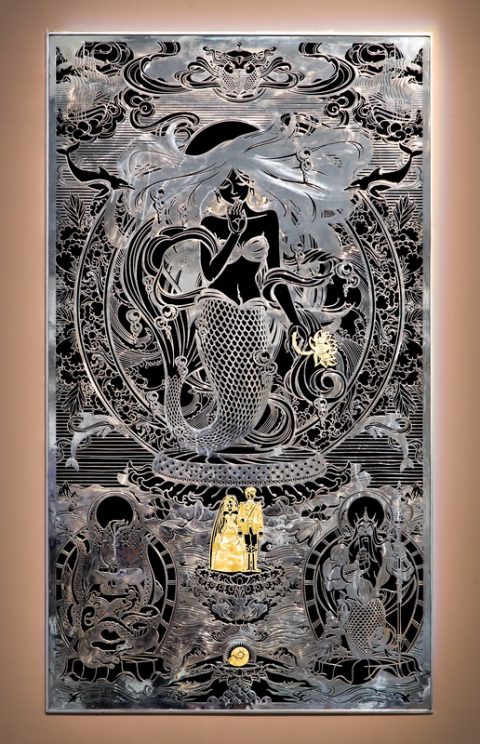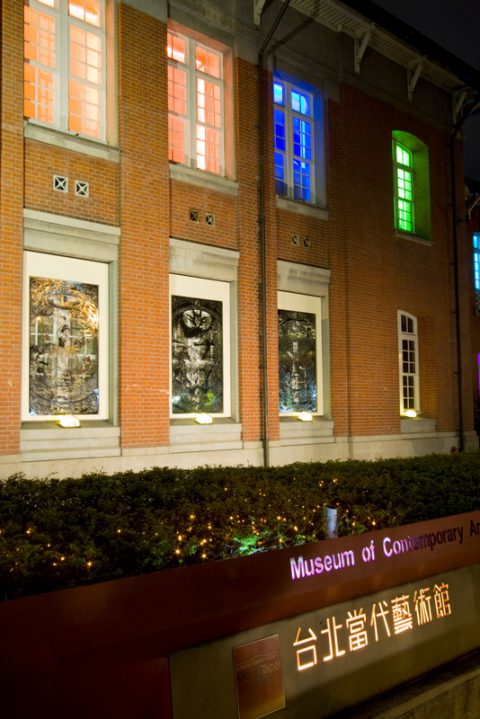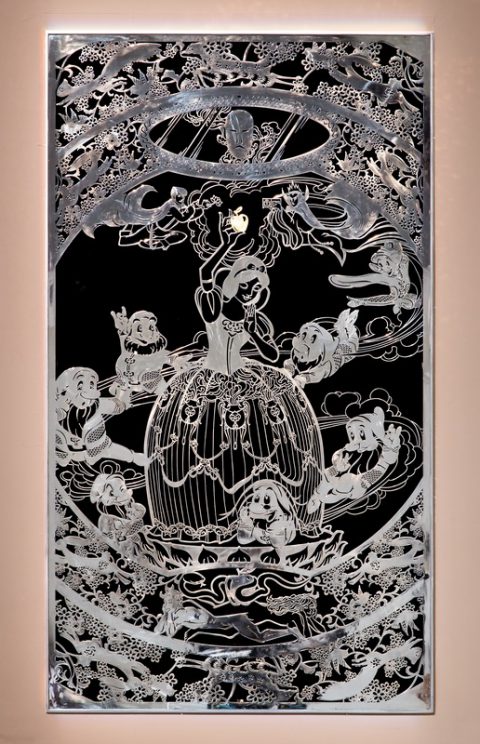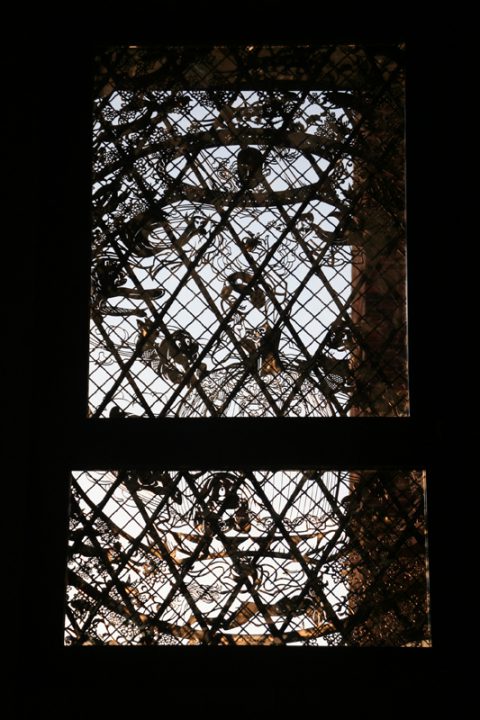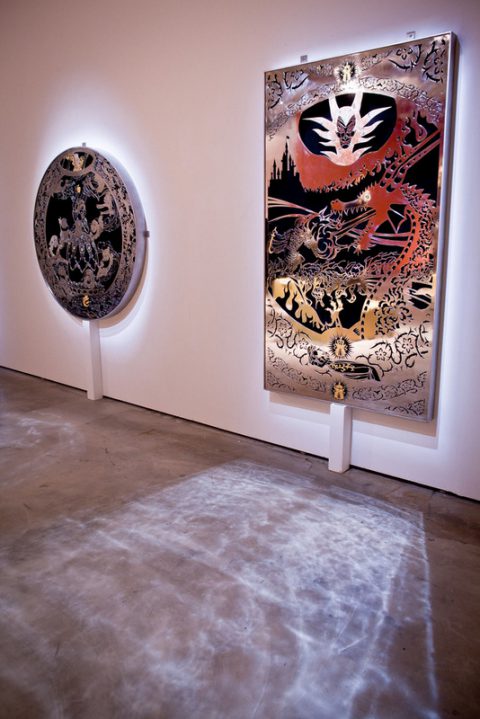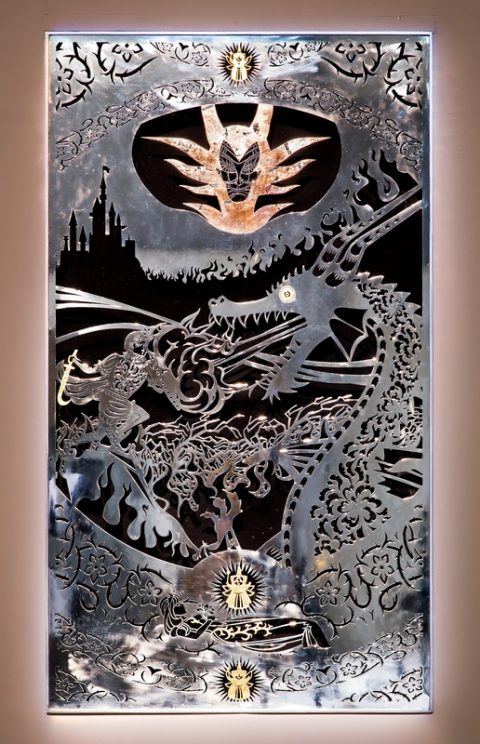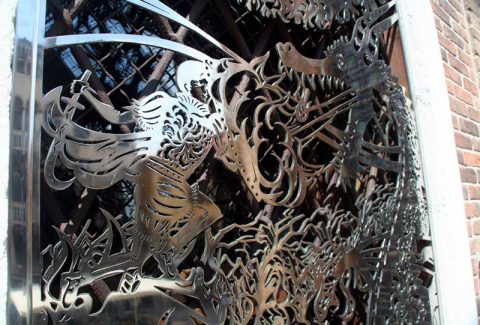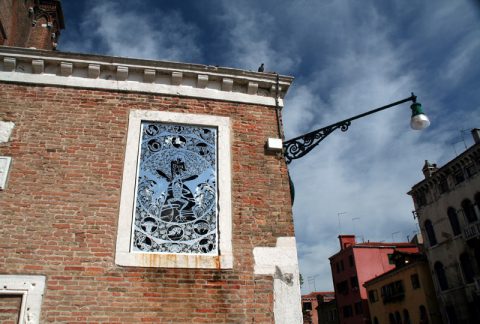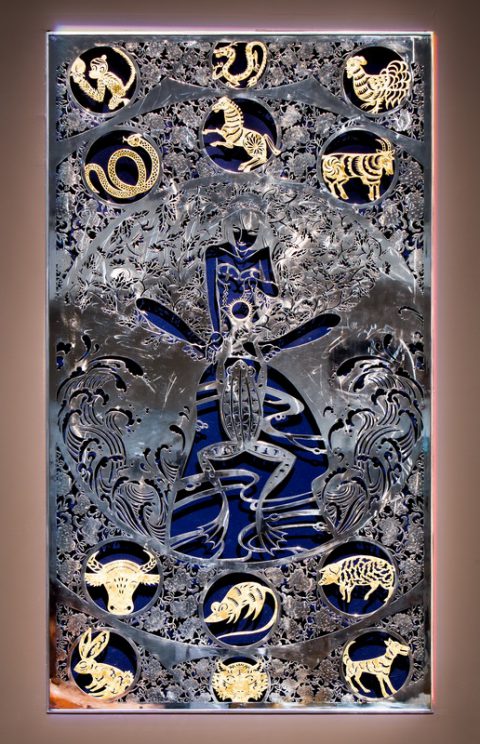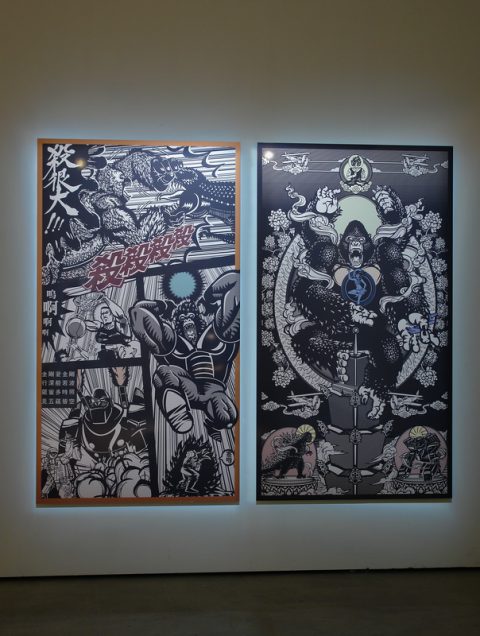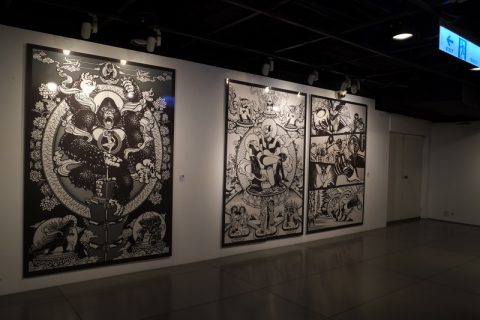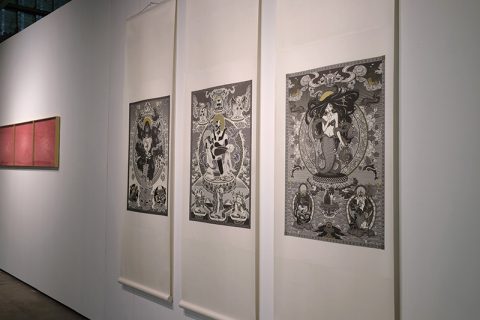2007-2009
楊茂林於此一系列所表達的,正是亙古以來人類所共通共修的嗔、癡、哀、樂之情,所謂愛情,是如此的簡單純粹,又是如此地滂薄而深刻,漫長的過程中,藝術家表示:因為創作而再三體會、時時重溫這些原是虛構的愛情故事,每每,心中仍湧出很多的感動。無論是銅鑄造的三個愛情悲劇,還是不銹鋼塑造的三個愛情喜劇,楊茂林都以密宗歡喜佛的造型與姿勢予以「神格化」,讓他們在蓮花座上結為連理。而佛教造像的特徵之一─神佛的背光,他則採取了以浮雕跟鏤刻兩種平面化的技術,呈現為整個浪漫愛情故事作總結視覺符號,製作成象徵神聖性的背光,闡述楊茂林心目中對於愛情的純粹與神聖性之想望。
A Story About Affection | 2007-2009
What Yang Mao-lin is trying to say here is that since ancient times humanity’s shared and mutually cultivated feelings of joy, sorrow, infatuation and anger – so-called love – are just that pure and simple, at once frivolous yet deep. Over the long haul, what he has repeatedly experienced and is constantly relearning is that these originally imaginary love stories can often still bring out a lot of emotions in him. Whether with the three tragic love stories in copper or the three comedy love stories in stainless steel, he has used the form and postures of the tantric Laughing Buddha to “deify” them, imbuing them with the common thread of the Lotus Position. And as to one of the symbolic characteristics of Buddhist statuary – the backlighting of the holy Buddha – he has employed the flat surface techniques of relief sculpture and engraving to display a summary visual marker for the whole of the romantic love story, creating the effect of a symbolically sacred backlighting, expounding upon the idealized purity and sacredness of love in his mind’s eye.
▲ ▼
有關愛情的故事–無敵愛金剛|銅雕、金箔|主尊120x87x54cm|2007
A Story About Affection—Extraordinary Love Vajradhara|bronze, gold foil|main 120x87x54cm|2007
有關愛情的故事–無敵愛金剛 (局部)
A Story About Affection—Extraordinary Love Vajradhara (part)
有關愛情的故事–金剛愛金剛|銅雕、金箔|主尊110x110x60cm|2008
A Story About Affection—Beloved King Kong Vajradhara|bronze, gold foil|main 110x110x60cm|2008
有關愛情的故事–金剛愛金剛 (局部)
A Story About Affection—Beloved King Kong Vajradhara (part)
有關愛情的故事–金剛愛金剛 (局部)
A Story About Affection—Beloved King Kong Vajradhara (part)
有關愛情的故事–人魚愛金剛|銅雕、金箔|主尊138x115x75cm|2008
A Story About Affection—Beloved Mermaid Vajradhara|bronze, gold foil|main 138x115x75cm|2008
有關愛情的故事–人魚愛金剛 (局部)
A Story About Affection—Beloved Mermaid Vajradhara (part)
有關愛情的故事–人魚愛金剛 (局部)
A Story About Affection—Beloved Mermaid Vajradhara (part)
有關愛情的故事–白雪樂金剛與七矮護法|不鏽鋼、金箔|主尊98x114x114cm|2007
A Story About Affection -Joyous Snow White Vajradhara and Seven Dwarfs Dharmapala|stainless steel, gold foil|main 98x114x114cm|2007
有關愛情的故事–白雪樂金剛與七矮護法|不鏽鋼、金箔|主尊98x114x114cm|2007
A Story About Affection -Joyous Snow White Vajradhara and Seven Dwarfs Dharmapala|stainless steel, gold foil|main 98x114x114cm|2007
有關愛情的故事–白雪樂金剛與七矮護法 (局部)
A Story About Affection -Joyous Snow White Vajradhara and Seven Dwarfs Dharmapala (part)
有關愛情的故事–青蛙喜金剛與宇宙超級無敵十二神蛙|不鏽鋼、金箔|主尊151×112.5x66cm|2008
A Story About Affection-Joyful Frog Prince Vajradhara with the Twelve Invincible Frogs|stainless steel, gold foil|main 151×112.5x66cm|2008
有關愛情的故事–青蛙喜金剛與宇宙超級無敵十二神蛙 (局部)
A Story About Affection-Joyful Frog Prince Vajradhara with the Twelve Invincible Frogs (part)
有關愛情的故事–青蛙喜金剛與宇宙超級無敵十二神蛙 (局部)
A Story About Affection-Joyful Frog Prince Vajradhara with the Twelve Invincible Frogs (part)
有關愛情的故事–青蛙喜金剛與宇宙超級無敵十二神蛙 (局部)
A Story About Affection-Joyful Frog Prince Vajradhara with the Twelve Invincible Frogs (part)
有關愛情的故事–青蛙喜金剛與宇宙超級無敵十二神蛙 (局部)
A Story About Affection-Joyful Frog Prince Vajradhara with the Twelve Invincible Frogs (part)
有關愛情的故事–青蛙喜金剛與宇宙超級無敵十二神蛙 (局部)
A Story About Affection-Joyful Frog Prince Vajradhara with the Twelve Invincible Frogs (part)
有關愛情的故事–睡美人悅金剛|不鏽鋼、金箔|主尊119x75x71cm|2009
A Story About Affection-Joyous Sleeping Beauty Vajradhara|stainless steel, gold foil|main 119x75x71cm|2009
有關愛情的故事–睡美人悅金剛 (局部)
A Story About Affection-Joyous Sleeping Beauty Vajradhara (part)
有關愛情的故事–睡美人悅金剛 (局部)
A Story About Affection-Joyous Sleeping Beauty Vajradhara (part)
無敵愛金剛之本生傳|不鏽鋼、金箔|207x118x8cm|2009
Jataka Tale of Extraordinary Love Vajradhara|stainless steel, gold foil|207x118x8cm|2009
無敵愛金剛之本生傳 (局部)
Jataka Tale of Extraordinary Love Vajradhara (part)
金剛愛金剛之本生傳|不鏽鋼、金箔|207x118x8cm|2009
Jataka Tale of Beloved King Kong Vajradhara|stainless steel, gold foil|207x118x8cm|2009
人魚愛金剛之本生傳|不鏽鋼、金箔|207x118x8cm|2009
Jataka Tale of Beloved Mermaid Vajradhara|stainless steel, gold foil|207x118x8cm|2009
人魚愛金剛之本生傳|不鏽鋼、金箔|207x118x8cm|2009
Jataka Tale of Beloved Mermaid Vajradhara|stainless steel, gold foil|207x118x8cm|2009
都是蘋果惹的禍之白雪公主版|不鏽鋼、金箔|207x118x8cm|2009
Jataka Tale of Snow White, the Seven Dwarfs and the Promised Prince|stainless steel, gold foil|207x118x8cm|2009
都是蘋果惹的禍之白雪公主版|不鏽鋼、金箔|207x118x8cm|2009
Jataka Tale of Snow White, the Seven Dwarfs and the Promised Prince|stainless steel, gold foil|207x118x8cm|2009
王子屠龍之睡美人版|不鏽鋼、金箔|207x118x8cm|2009
Jataka Tale of the Prince Killing the Dragon and Saving the Sleeping Beauty|stainless steel, gold foil|207x118x8cm|2009
王子屠龍之睡美人版 (局部)
Jataka Tale of the Prince Killing the Dragon and Saving the Sleeping Beauty (part)
還君明珠之青蛙王子版|不鏽鋼、金箔|207x118x8cm|2009
Jataka Tale of the Princess and the Frog|stainless steel, gold foil|207x118x8cm|2009
還君明珠之青蛙王子版|不鏽鋼、金箔|207x118x8cm|2009
Jataka Tale of the Princess and the Frog|stainless steel, gold foil|207x118x8cm|2009
金剛愛金剛之本生傳|金屬相紙|215x120cmx2|2011
Jataka Tale of Beloved King Kong Vajradhara|
metallic photo paper|215x120cmx2|2011
苦海三聖|數位輸出/絲絹|畫心77.4x54cm x 3|2019
The Three Sages in the Ocean of Misery|digital output, silk|image77.4x54cm x 3|2019

